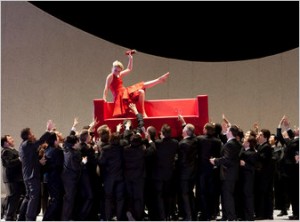 There was some booing last night, when director Willy Decker came on stage…but not a lot. Good thing, because this is the most exciting Traviata in years.
There was some booing last night, when director Willy Decker came on stage…but not a lot. Good thing, because this is the most exciting Traviata in years.
I could write two reviews of last night’s New Year’s Eve premiere of La Traviata.
My opera partner Charlie and I were there with six opera novices, who were awfully good sports about spending New Year’s Eve with us. For these once-a-decade opera goers, La Traviata was a bust. They want the Zefferelli Met, filling every inch of that oversize stage with color, costume, and spectacle.
Instead, they got new Met, spare, provocative, contemporary. Peter Gelb’s Met.
An interesting conundrum, critically and commercially. But I’ll pretend that the commercial issue doesn’t exist, and just focus on the questions of musical and theatrical success. Even better, let’s stipulate the music. There was never a more melodious, soulful opera than this, every minute another gorgeous aria, and escaping by a hair the over-exposure of La Boheme. I won’t presume to say anything about the lovely Marina Poplavskaya, who manipulates her voice and her long blond hair with almost equal effectiveness. A bit thin on top….oh no! I promised not to say anything about her singing. Can I mention that she is the most fabulous actress ever? Can’t say the same about the American tenor Matthew Polenzani, who has a charming voice but is awfully clumsy as an actor.
Back to our production: I woke up this morning with a slight champagne headache but mostly, I was thinking about Violetta. Weird and true. Any production that can do that is a huge success. Decker made it all about her. Her red dress stands out among the black and white performers. She is alive, singular, individual, struggling, and they are a mob.
Spare? This production hardly has a peg of furniture on stage. Not a desk or a chair. Only some parsons coaches that look like they were thrown out of a Sims City setting. Violetta and Alfred: the Sims….what a thought.
It is the second act that brings it all home. In traditional productions, the second act is usually set in a charming and luxurious country house, a Pierre Deux coffee table setting, complete with faux natural light streaming in through french doors. Violetta and Alfredo have retreated from Parisian life and are playing house on borrowed time and her borrowed courtesan profits.
Instead, the Decker production has Violetta and Alfredo rolling around in couches covered with floral fabric, and they are wearing the same fabric. No hint of sunlight, nothing natural or rural about their love nest. In fact, the absence of any hint of the “real world” intensifies the sense of their claustrophobic, rule-ridden world. They haven’t left it behind now; they can’t escape.
But here we also endure some avoidable mistakes. Alfredo in boxer shorts? This has him singing some luscious music while literally pulling on his pants and zipping his fly, getting dressed so he can race back to Paris and save Violetta’s savings account. Really, it just doesn’t work. Note to Met: no boxer shorts. We also get too much of red dress as a symbol….ever since Schindler’s List, red clothing registered its shock….wait! What about the red raincoat in Don’t Look Back, well before Schindler. Anyway, here is it used to beat the audience over the head with the moral of the story: had we but world enough and time, this coyness mistress….you know the next.
By comparison, I saw La Fanciualla a few weeks ago. The Met’s creaky old production took that majestic music and made it downright boring. I was so excited to see this rarely performed opera, and nearly left early.
If you want the spectacle and literalism of the 19th productions, watch a DVD. If you want to see how opera can and should be invented in the 21st century, come to La Traviata. I can’t wait to see it again.
cf. Tommasini’s good (as in favorable, and also interesting) review in NYT